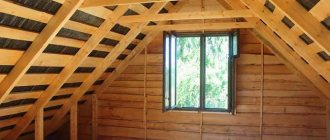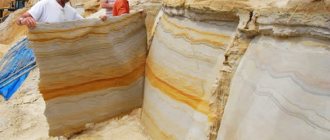Today, almost every owner of a private or country house takes care of his comfort and has his own plumbing system.
In the summer, using water supply is just a pleasure, but with the arrival of winter, it will be necessary to insulate the water supply pipes outside, otherwise they will completely freeze and burst in just a week at a temperature below - 5 degrees, leaving the owners without water.
Any material, even the highest quality, will not be able to withstand prolonged frosts in severe winters.
There are many options for how to perform insulation and the choice of materials depends on the location and thermal insulation of the pipeline. Using separate methods, insulation is carried out for pipes installed indoors, in the ground or outdoors.
General information
How to insulate street water supply?
Laying a water pipeline two meters deep in the ground does not guarantee that it will not freeze during severe frosts. And under no circumstances should the water inside the structure be allowed to freeze, otherwise it can rupture and damage the entire plumbing system.
Therefore, it is worth taking care in advance about protecting the water supply from freezing outside and choosing the right insulation.
There are two weak points in a home plumbing system.
- The location of the pipeline on the street under a layer of earth.
- The pipeline is located in an unheated room.
If it is easier to insulate the water supply in a private house that is located indoors, then the water supply that is laid outside requires a more thoughtful approach. Basically, it all depends on the quality of the insulation used.
A good insulation for water supply should have the following characteristics:
- low thermal conductivity;
- durability;
- ease of installation;
- resistance to aggressive environments;
- must withstand the operating temperature of the environment;
- fire safety and tightness;
- low price with the possibility of repeated use
Based on these characteristics, the optimal thermal insulation for water supply in a private house is selected. Today there are a large number of insulation materials. Below we will analyze some of them.
Equipment for heating pipelines
Self-Regulating Electric Heating Tape HTM
| Max. t°С | 65 °C |
| Max. permissible temperature | 85 °C |
| Ambient temperature range | -60…+55 °С |
| Minimum installation temperature | -60 °C |
| Power supply | ~220–240 V |
| Temperature class | T6 |
| Max. braid resistance | 10 Ohm/km |
Price on request
Self-Regulating Electric Heating Tape HTA
| Max. t°С | 65 °C |
| Max. permissible temperature | 85 °C |
| Ambient temperature range | -60…+55 °С |
| Minimum installation temperature | -60 °C |
| Power supply | ~220–240 V |
| Temperature class | T6 |
| Max. braid resistance | 10 Ohm/km |
Price on request
Self-Regulating Electric Heating Tape HTP
| Max. t°С | 65 °C |
| Max. permissible temperature | 85 °C |
| Ambient temperature range | -60…+55 °С |
| Minimum installation temperature | -60 °C |
| Power supply | ~220–240 V |
| Temperature class | T6 |
| Max. braid resistance | 10 Ohm/km |
Price on request
Self-Regulating Electric Heating Tape BTC
| Max. t°С | 120 °C |
| Max. permissible temperature | 190 °C |
| Ambient temperature range | -60…+55 °С |
| Minimum installation temperature | -60 °C |
| Power supply | ~220–240 V |
| Temperature class | T4 |
| Max. braid resistance | 10 Ohm/km |
Price on request
Self-Regulating Electric Heating Tape BTX
| Max. t°С | 120 °C |
| Max. permissible temperature | 250 °C |
| Ambient temperature range | -60…+55 °С |
| Minimum installation temperature | -60 °C |
| Power supply | ~220–240 V |
| Temperature class | T3 |
| Max. braid resistance | 10 Ohm/km |
Price on request
Self-Regulating Electric Heating Tape HTB
| Max. t°С | 65 °C |
| Max. permissible temperature | 85 °C |
| Ambient temperature range | -60…+55 °С |
| Minimum installation temperature | -60 °C |
| Power supply | ~22–24 V |
| Temperature class | T6 |
| Max. braid resistance | 10 Ohm/km |
Price on request Frost protection for household pipelines - Installation and operation instructions URL: https://warm-on.ru/categories/gotovye-sistemy-obogreva
Requirements that insulation must meet
Since this material is intended to protect water pipes from frost, it must have a number of characteristics.
Before insulating the water supply system on the street, you should know that, despite their diversity, each of them must meet the following requirements:
- minimal thermal conductivity to retain the maximum amount of heat;
- water-repellent properties that will provide airtight protection;
- antifungal properties that prevent putrefactive processes from developing;
- resistance to various aggressive environments that can affect a certain area of the structure;
- resistance to high temperatures and fire;
- long service life.
Before insulating a water supply system above the ground, think carefully about choosing insulation so that later there will be no difficulties during the installation process.
If the work will be carried out by a non-professional craftsman, then it is desirable that the insulation process does not require a large number of tools.
Temperature depending on the indicator
To clearly determine the freezing point, you must first understand how these 2 parameters are related.
How are they interconnected?
As the pressure increases, the freezing temperature decreases, and as the pressure decreases, the temperature increases. There are special formulas that help calculate a specific value .
The table of such ratios looks like this:
| Temperature, °C | Pressure, mPa |
| 0 | 0,1 |
| -1 | 1 |
| -2 | 30 |
| -3 | 40 |
| -4 | 50 |
| -5 | 60 |
| -10 | 110 |
| -22 | 210 |
Glass wool, mineral wool and polystyrene foam
This type is produced from waste from the glass industry. The material has appropriate properties and is most often used to insulate outdoor water supplies made of plastic.
At the same time, it is relatively inexpensive and can be purchased directly in rolls. How to insulate a water pipe with glass wool? To do this, the water supply (the part that is in the ground) is wrapped, and then the whole thing is secured with soft thin wire or construction tape.
We can assume that the thermal insulation of the water supply on the street has been achieved, however, this type of thermal insulation requires the use of an additional method of waterproofing (coating with roofing felt), which increases the price of the work due to the presence of a second layer.
Also, when working with glass wool, you need to use special clothing, gloves and a mask. The fiber of this insulation is very thin, so it can easily penetrate under the skin or into the respiratory tract.
When choosing mineral wool , which is made on the basis of basalt fiber, before starting insulation, you need to purchase special cylinders of a certain diameter and size.
They are also called “shells” in construction circles. They are easily cut with a regular knife.
These cylinders are often additionally coated with aluminum foil on the outside, which will provide additional protection from mechanical damage during operation.
Using a foil shell, you can quickly solve the problem of how to insulate water pipes above ground and prevent heat loss.
If we are talking about cold water supply pipes, then in this case you can use polystyrene foam shells, but you need to take into account that this material is flammable, so it cannot be used as an insulating material in hot water supply systems.
Before you insulate your outdoor water supply and choose the appropriate material, please note that mineral wool consists of small fibers, which fly apart during operation and can enter the respiratory tract, causing allergic reactions and irritation.
You can work with mineral wool only in special clothing, while foam plastic is easy to install and does not require special instructions for use.
Pipe heating with cable
Currently, this method is most widespread. The idea is simple. After all, winter, even the harshest, lasts only a few months. Therefore, the pipeline can freeze only during this cold period.
If instead of 2 meters you bury a pipe 50 cm deep, wind a heating cable around it and insulate it, then the water will not freeze.
If you take a branded cable, then its cost can range from 400 to 500 rubles. per linear meter. The distribution power is 10-20 W per linear meter. If you want something cheaper, you can use regular wire. A heating cable made at home is usually low voltage. In theory, it can be used both outside the pipe and inside. However, it is worth remembering that even at low voltage, the current can affect pets.
Typically, the water supply freezes where the pipe enters the house. If you wrap it with a few meters of cable, the problem can be eliminated.
Basalt insulation and foam plastic
Good insulation is made from basalt using the melting method. Cylinders of different diameters are produced from it, which are used as insulation.
In addition to ease of installation, basalt cylinders fit perfectly into the pipeline. The price of this material is higher than the price of glass wool, but it also requires protection from moisture, which is foil insulation or glassine.
Insulating the water supply on the street is an important point, for which polystyrene foam is most often used in practice. To insulate any pipeline, a shell of suitable diameter is made.
They come with or without coating. The foam shell can be used several times, which saves money, while it has the most suitable operational and technical characteristics as insulation.
Ways to prevent freezing
The most effective methods for preventing the formation of ice jams include:
- Correct installation of the pipeline to a sufficient depth.
- Arrangement of sand and gravel cushion.
- Thermal insulation of the system.
- Supply of the pipeline with heating cables with temperature sensors.
Do not overuse heating using a heating cable.
In addition to the fact that this is a significant waste of electricity, continuous operation will shorten its service life several times. Be sure to remember that high-quality protection of pipes at the stage of their installation will greatly facilitate their operation in the future. No matter how carefully the work to warm them is carried out, there is a very high risk of damage from the direct expansion of the ice inside. There is a high probability that with the onset of heat it will be necessary to carry out repair work and replace damaged sections of the system.
Add a comment
How to properly install a foam shell
How to insulate a water pipe with polystyrene foam? To install the shell correctly, you do not need to have any specific skills. Thermal insulation of water supply in this way can be done with your own hands in a short period of time.
The cylinder halves are put on the pipe and secured with special tape. The parts must be installed with an overlap (at least 10 cm). Also, all joints are carefully sealed with tape and a protective layer is applied to the tape.
Shaped shells are used for corner segments, nodes and turns.
Dismantling the insulation is carried out in the reverse order, removing the protective layer, adhesive tape, and then the shell itself.
Thermal insulation Energoflex
This heat-insulating material is made of foamed polyethylene. Thermal insulation for water supply pipes from the Energoflex company has a cellular structure and is ideal for thermal insulation of outdoor water pipes.
Energoflex thermal insulation guarantees high-quality insulation of outdoor water supply and is manufactured using advanced technologies using the latest equipment. The range of products offered is constantly increasing depending on customer demand.
Energoflex thermal insulation has the following characteristics:
- retains heat well. Has a low thermal conductivity coefficient;
- protects the media from overheating. Even in hot weather, the water will be cool;
- protects the pipeline that is located in the ground from freezing. Energoflex thermal insulation, even in an open area, can protect against freezing for some time in case of problems, until they are eliminated;
- protects the pipeline from condensation and corrosion. Thermal insulation Enegroflex is highly resistant to aggressive environments, therefore it can protect the water supply material from the corrosion process;
- Energoflex also has sound insulation; it effectively hides structural noise to maintain silence indoors and outdoors.
Energoflex thermal insulation is used not only as insulation for water supply pipes that are located in the ground outside, but also when installing “warm floors”, in roofing work, etc. This material has a large number of products for insulation and insulation.
These include materials in rolls, in the form of tubes and additional connecting accessories that are needed for high-quality installation of outdoor water supply insulation. Energoflex, official representative: energoflex.ru.
Self-adhesive thermal insulation for pipes Energoflex® Super SK
Alternative Methods
Protection against freezing of water supply cannot always be effectively achieved using only insulation. In severe frosts, additional protection against freezing may be required, which can be achieved using special heating cables or pressure.
Everyone knows that for every liquid there is a pressure at which it does not freeze. Thermal insulation of water pipes can also be associated with this rule. It is enough to simply embed the receiver into the pipeline.
To ensure equal pressure throughout the pipeline, a check valve is installed near the pump. Then you should close the tap installed in front of the receiver and turn on the pump.
It is optimal to create a pressure of 3 to 5 atmospheres. The main thing is that all pipeline elements can withstand such pressure. If the system can withstand such pressure, then most likely it will not freeze in winter frosts.
When it warms up, it is enough to simply normalize the pressure and the water supply can operate as usual. Protecting water pipelines using this method is possible using a submersible pump, which can create a pressure of up to 5 atmospheres.
Insulation of water pipes in the ground can be done using special electrical cables. How to insulate it using this method? The wires are laid on the water pipe longitudinally or in the form of a spiral and covered with a layer of insulation.
This method is very reliable if there is constant access to electricity. Using this method, you can heat the pipeline in one day.
Heating of underground water supply systems
To the question of how to insulate a water pipe under the floor, the answer is very simple. Most often they are wrapped in glass wool, which is secured with wire or plastic wrap.
Insulation of water pipes
This heating method is good for outdoor use, but when burying a water main with soil, it is necessary to cover the glass wool with a waterproofing layer.
Under the influence of the earth, the insulating material, the density of which is low, will gradually begin to deteriorate and the thermal insulation is impaired.
Another method of insulation is to use wire to heat the water pipes.
This method for insulating the water supply system will be more expensive, but if you install the cable yourself, you can save a lot.
Self-regulating heating cable https://elektrokhv.ru/
Such a system is turned on only in the coldest winter months and makes it possible to insulate a water pipe under the floor without burying it deeply; it is enough to dig a trench half a meter deep.
You can place the wire for heating water pipes both on the inside and on the outside, the result will be good in each case.
But if you can attach the wire for heating the water supply on the outside yourself, then for the internal location of the cable you need to call specialists.
External cable fastening is carried out in two ways: longitudinal and spiral. You need to know in advance at what distance from each other the heating wire should be located and how many turns will need to be installed for optimal operation of such a system.
You will definitely need to install thermal sensors next to the cable in order to be able to control the temperature. This method of insulation is not only the most effective, but also reliable.
Now it’s easy to understand how to insulate a pipe under the floor or underground. Using an electric wire to heat pipes installed under a layer of insulation, you can raise the temperature to the optimal value throughout the day, even in the most severe frosts.
The only disadvantage of this method is its complete dependence on the power supply, so you should not rely entirely on this option.
If there is a power outage, the water heating wire will not be able to perform its function and you should always have a backup solution to the problem on hand.
It is also recommended to install a relay when installing the cable, because some types of cable in a self-regulating state do not turn off the power and can use electricity unnecessarily.
Heating cable installation process
To install the wire you will need to perform the following manipulations:
- the pipes are dug out, the trench is expanded so that insulation work can be freely carried out;
- a heating wire is wound onto the pipe using any of the above methods;
- a layer of heat insulator (polystyrene foam or glass wool) is placed on top of the electrical cable;
- installation of a protective covering (winding with fiberglass or sheet fabric), which is secured with soft wire;
- the edges of the cable are connected to the electrical network;
- pipes are filled up.
The result is multi-layer protection, which consists of a cable, insulation, protective coating and a layer of earth.
It is worth considering that those parts of the plumbing system that are inclined do not need to be insulated at all; in such places, liquid stagnation and freezing are excluded.
Part 3. Laying a pipeline from the well to the house
And the owner of the house decides how to insulate the water supply system above ground. It is advisable to use synthetic insulation, which retains heat well and does not rot.
The correctly chosen method of insulation, using heating wire or ordinary insulation material, will save not only money, but also nerves.
You should not skimp on thermal insulation, because ruptures and replacement of damaged sections of the plumbing system will cost much more.
All insulation work must be carried out in advance during the warm season and should not be delayed until the first frost, when the first problems arise. Now you know how to insulate a water pipe on the street, and you are able to cope with this task yourself.
Constantly circulating water
When it is not possible to resort to technical sophistications, it is enough to simply leave a tap open so that the water constantly flows in a thin stream. The method is simple. Yes, it is not always justified because if water flows into the septic tank, it overflows, because... even the thinnest stream can turn into hundreds of liters per day. In this case, already purified drinking water is poured out. In addition, electricity is senselessly wasted on its supply. Another disadvantage of this method is that summer residents often simply forget to open the treasured tap. After all, the habit of keeping the water well closed makes itself felt. And this, as you might guess, leads to freezing of the water supply.
Is it possible to properly circulate water? Can. To do this, you need to duplicate the water pipe. The second one will be used as a return line. During operation, the pump pumps water out of the existing well, drives it through these two pipes and returns it back to the well.
To reduce the load on the pump, you can set a timer. With its help you can set the frequency of operation of the unit. For example, 1-2 minutes of work after 30 minutes of rest. At the same time, the water will not have time to freeze, and electricity will be saved.
When a liter of water freezes, 330 kJ of thermal energy is released. In terms of cotton wool, this amounts to 90 W*hours. Heat loss per linear meter of pipe is approximately 10-15 W.
When we know the diameter of a given pipe and the volume of water that is in it, we can calculate the frequency of pump operation with which it is necessary to replace cooled water with warmer water from the well.
Foamed polyethylene
Many experts note that among the variety of thermal insulation materials, it is polyethylene varieties that are the most optimal in terms of price/quality ratio. The structure of polyethylene consists of many closed cells, inside of which there is air, which, as is known, has the lowest thermal conductivity coefficient - only 0.024 W/m*K. There are:
- cross-linked (FPPE or HPPE) polyethylene foam, which is obtained by foaming the molten composition;
- non-crosslinked (NPE) polyethylene foam, for the production of which an extruder is used.
The structure of NPE is long linear molecules, between which there is no chemical bond. While cross-linked polyethylene has a denser consisting of smaller cells , with a stable molecular bond. You can even distinguish these two varieties visually.
Depending on the production method, the technical characteristics differ .
- Cross-linked polyethylene will have a lower thermal conductivity and higher density , making it resistant to deformation. But its cost higher than unstitched. Density ranges from 25 to 40 kg/m3 ;
- The material has increased elasticity , which is maintained even at low temperatures (-80°C) . This makes installation much easier;
- With a force of 5000 N/m2. the compression ratio of polyethylene is only 0.2;
- Due to the minimum value of the vapor permeability , which is 0.001 mg/m*h*Pa, the material can be classified as completely vapor-proof ;
- Coefficient of thermal conductivity amounts to 0.035 W/m*K;
- Polyethylene also has a low water absorption rate . When the material is immersed in water for a day, it absorbs no more than 0.5% of moisture from its volume. Moreover, upon reaching the figure of 1.9% after more time, water absorption stops increasing;
- The flammability class of the material is G2 ( moderately flammable );
- Moreover, in the event of inflammation, the material does not release substances to the body ;
- The structure of the material is not susceptible to the effects of various chemical elements .
- Polyethylene may have release form in the form of hollow cylinders with a technical slot along the entire length, sheets and rolls.
The material may have an additional protective layer of foil .
Reasons for defrosting heaters
The main reasons for freezing of air heaters are:
- Winter period: outside temperature drops below -10 degrees.
- The coolant temperature in the supply pipeline is below +45 degrees.
- The amount of impurities contained in the pipeline system operating for the ventilation system exceeds permissible standards, which leads to clogging of individual heat exchanger coils and, as a result, freezing of water in these areas.
- The power supply to ventilation systems is intermittent and the circulation pump is turned off.
- Features of the design of heat exchangers (water heaters). Most European manufacturers make heat exchanger tubes with a smaller diameter than required for operation in Russian conditions.
- Incorrect choice of control unit circuit.
- Control valves are selected with high Kv, and drives with low speed.
- Lack of return coolant sensor and capillary anti-freeze thermostat.
- Faulty automatic systems, lack of frost protection.
- Uncoordinated operation of exhaust systems when the supply systems are turned off (air leaks through closed blinds), etc.
Air insulation
Understanding the characteristics of soil freezing in winter, you can use the thermal insulation method, when warm air from the bowels of the earth is used to heat the pipe. As you know, the soil freezes from top to bottom, while heat continues to flow from below. When insulating shells are used, this heat is simply cut off and not used.
To
save on the amount of insulation materials, you can create a structure that will resemble an umbrella . And work on the same principle. The cold from above will be insulated , and the heat coming from below will be concentrated at the depth of the pipeline.
This can be done using a flexible material with low thermal conductivity, which is laid in an arc over the pipe in a trench and then simply covered with soil. Additionally, you can fill the free space around the pipe with expanded clay. The article was written for the site.
Tags:Pipes











